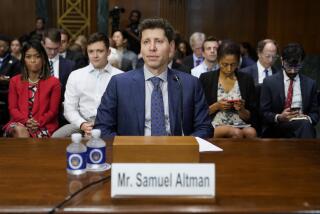To Promote Technology, Government Should Simply Get Out of the Way
- Share via
The Clinton Administration is right in proposing a new technology policy for the United States.
The existing array of federal activities to promote research and development remains unchanged from the Cold War and is out of date. But the Administration is wrong in proposing that encouragement to commercial technology should take the form of subsidies from the U.S. Treasury.
By its nature, commercial technology is oriented to the private sector. It is private companies that produce and market the goods and services embodying the advances in science and engineering.
In order to be effective, any new technology policy should be geared to the basic incentives of a private-enterprise system.
In its reliance on federal spending, the Clinton Administration’s technology program has introduced one innovation. It has broadened the standard definition of infrastructure beyond the traditional bridge building and road construction to include a variety of high-tech projects: magnetic levitation transportation and high-speed rail; “smart highways”; a “clean automobile” powered by batteries or fuels such as hydrogen, and a national information “superhighway” to link computers around the nation.
Past experience with government trying to force-feed technological innovation is not comforting. Three billion dollars was wasted in the abortive attempt to develop a commercial synthetic fuels industry.
To quote a recent assessment of the synfuel program by Linda Cohen and Roger Noll for the Brookings Institute: “The entire synfuels program had a quality of madness to it. . . . Goals were unattainable from the start.”
Synfuel is not an isolated example. Similar failures occurred in the supersonic transport project and in the Clinch River breeder reactor.
Today, look at the space shuttle still seeking to define its mission and the financially hemorrhaging superconducting super collider.
As any cynic or seasoned observer of the Washington scene would readily expect, the notion of government subsidy to commercial technology has attracted support from many quarters, including suppliers of equipment as well as prospective users.
Proponents of federal subsidies to private business cite the example of Japan’s Ministry of International Trade and Industry. However, its decisions have not been altogether wise. MITI attempted to keep Sony from entering the consumer electronics market and Mazda and Honda from getting into the auto business.
High-definition television provides an example of Japanese government failure. Japan chose the technology to be used for HDTV and financed its development. However, the analog technology it selected turns out to be inferior to the alternatives that U.S. industry has developed using a higher-quality digital technology.
The current Clinton proposal for government to build a new high-tech telecommunications network (the data superhighway) provides a striking case in point of avoidable government subsidy to high technology. The quickest way to achieve a data superhighway is to permit the phone and cable companies to compete on the basis of their existing and prospective technologies.
There is little in the history of federal support for technology to justify the optimism that underlies the Administration’s approach. Government is not good at choosing which areas of technology to support and which organizations should do the work.
We are much better off when private enterprises risk their own capital in selecting technological activities and then carry through on the successful ventures.
Government can play an important role in promoting technology. That role is to eliminate the obstacles to innovation created by government itself. Numerous regulatory restrictions inhibit the growth and application of corporate R&D.;
It’s futile for the government to pour vast sums into high-tech enterprises while it continues to erect statutory and administrative roadblocks to the application of those new technologies. It is like a driver who has one foot on the gas pedal and the other on the brake.
In many cases--chemicals, pharmaceuticals and biotechnology--the major constraint on commercializing technology arises from government itself.
Consider the use of the protein BST in increasing the production of milk. Because it reduces the price of milk, state legislatures are preventing the use of this advance in biotechnology.
Governmental actions like that have a powerfully negative effect on the incentive to commercialize new technology, notwithstanding the federal financial support.
Technology policy is the newest euphemism for discredited industrial policy. Business executives rarely advocate industrial policy. Rather, according to a former senior Commerce Department official, “They want the government involved in high-risk, long-term, expensive, high-technology research projects.”
Or, in the words of one academic supporter, “The government should not give handouts, but it should help strategically placed industries at strategic times.”
Inevitably, the political process selects the specific industries and projects. By definition, the chosen few meet these subjective requirements.
Politically weak companies by default are not “strategic,” “high-risk” or “long-term.” The results are indistinguishable from a federal spending program formally labeled “industrial policy.”
Some obstacles to commercialization of technology arise in the private sector. Despite superior American achievements in science, Japanese firms are strong competitors because they assign more talent to detailed product design and quality control.
They place their most talented engineers in production. Much of their product development is done in the factory rather than in a remote laboratory. Thus, Japanese firms often respond more quickly to market opportunities and achieve lower costs and better quality than U.S. manufacturers.
There is only one place to lodge the responsibility for dealing with such challenges to American management and that is, of course, business management itself.
More to Read
Inside the business of entertainment
The Wide Shot brings you news, analysis and insights on everything from streaming wars to production — and what it all means for the future.
You may occasionally receive promotional content from the Los Angeles Times.










